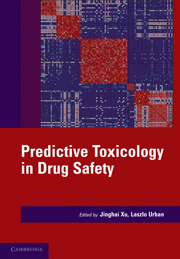Book contents
- Frontmatter
- Contents
- Contributors
- Prologue – Predictive toxicology: a new chapter in drug safety evaluation
- PREDICTIVE TOXICOLOGY IN DRUG SAFETY
- I SPECIFIC AREAS OF PREDICTIVE TOXICOLOGY
- II INTEGRATED APPROACHES OF PREDICTIVE TOXICOLOGY
- 10 Integrated approaches to lead optimization: improving the therapeutic index
- 11 Predictive toxicology approaches for small molecule oncology drugs
- 12 Mechanism-based toxicity studies for drug development
- 13 Fish embryos as alternative models for drug safety evaluation
- 14 The role of genetically modified mouse models in predictive toxicology
- 15 Toxicogenomic and pathway analysis
- 16 Drug safety biomarkers
- 17 Application of TK/PD modeling in predicting dose-limiting toxicity
- 18 Prediction of therapeutic index of antibody-based therapeutics: mathematical modeling approaches
- 19 Vaccine toxicology: nonclinical predictive strategies
- Epilogue
- Index
- Plate section
- References
18 - Prediction of therapeutic index of antibody-based therapeutics: mathematical modeling approaches
from II - INTEGRATED APPROACHES OF PREDICTIVE TOXICOLOGY
Published online by Cambridge University Press: 06 December 2010
- Frontmatter
- Contents
- Contributors
- Prologue – Predictive toxicology: a new chapter in drug safety evaluation
- PREDICTIVE TOXICOLOGY IN DRUG SAFETY
- I SPECIFIC AREAS OF PREDICTIVE TOXICOLOGY
- II INTEGRATED APPROACHES OF PREDICTIVE TOXICOLOGY
- 10 Integrated approaches to lead optimization: improving the therapeutic index
- 11 Predictive toxicology approaches for small molecule oncology drugs
- 12 Mechanism-based toxicity studies for drug development
- 13 Fish embryos as alternative models for drug safety evaluation
- 14 The role of genetically modified mouse models in predictive toxicology
- 15 Toxicogenomic and pathway analysis
- 16 Drug safety biomarkers
- 17 Application of TK/PD modeling in predicting dose-limiting toxicity
- 18 Prediction of therapeutic index of antibody-based therapeutics: mathematical modeling approaches
- 19 Vaccine toxicology: nonclinical predictive strategies
- Epilogue
- Index
- Plate section
- References
Summary
Biologics represent a landmark shift in the pharmaceutical industry. The global market for human medicines was $750 billion and global sales of biologic medicines were $87 billion in 2008. Monoclonal antibodies (mAbs) represented one of the most important classes of biologics with sales of $33 billion. Remicade (infliximab; Centocor) for Crohn's disease was the market leader, followed by Rituxan (rituximab; Genentech) for non-Hodgkin's lymphoma, Herceptin (trastuzumab; Genentech) for HER2–positive breast cancer, Avastin (bevacizumab; Genentech) for colorectal cancer, Humira (adalimumab; Abbott) for rheumatoid arthritis, Synagis (palivizumab; Medimmune) for pediatric respiratory disease, and Erbitux (cetuximab; Imclone Systems) for colorectal cancer. The growing interest in using mAbs as therapeutics lies in their exquisite specificity for the target antigen. Unlike small-molecule therapeutics, which almost always show off-target effects due to overlapping activities against related members of enzyme families, antibodies can be targeted to individual protein targets. High specificity of antibody–antigen interaction can lead to a desirable therapeutic with high efficacy with minimal nontarget side effects.
MATHEMATICAL MODELING IN DRUG DISCOVERY
Mathematical modeling in the pharmaceutical industry has been done traditionally in the pharmacokinetic, pharmacodynamics, and drug metabolism groups. Researchers in these groups employ the tools of pharmacokinetic-pharmacodynamic (PKPD) modeling. Generally, a model is picked to best fit the animal data, and this model is used for translation from animal to human data for dose predictions based on allometric scaling (i.e., parameters of the models are scaled based on body weights of the species).
- Type
- Chapter
- Information
- Predictive Toxicology in Drug Safety , pp. 330 - 343Publisher: Cambridge University PressPrint publication year: 2010



